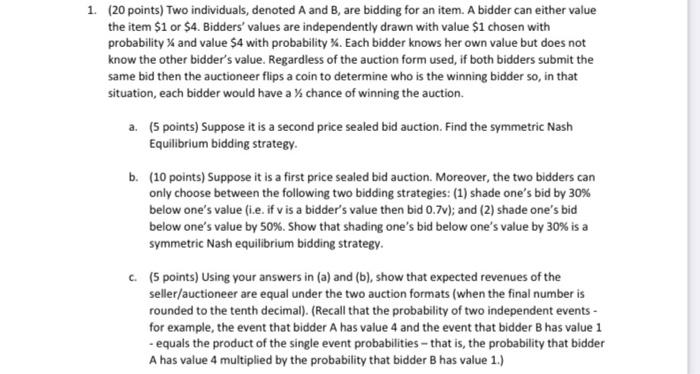1. (20 points) Two individuals, denoted A and B, are bidding for an item. A bidder can either value the item $1 or $4. Bidders' values are independently drawn with value $1 chosen with probability and value $4 with probability %. Each bidder knows her own value but does not know the other bidder's value. Regardless of the auction form used, if both bidders submit the same bid then the auctioneer flips a coin to determine who is the winning bidder so, in that situation, each bidder would have a chance of winning the auction. a. (5 points) Suppose it is a second price sealed bid auction. Find the symmetric Nash Equilibrium bidding strategy. b. (10 points) Suppose it is a first price sealed bid auction. Moreover, the two bidders can only choose between the following two bidding strategies: (1) shade one's bid by 30% below one's value (i.e. if v is a bidder's value then bid 0.7v); and (2) shade one's bid below one's value by 50%. Show that shading one's bid below one's value by 30% is a symmetric Nash equilibrium bidding strategy. (5 points) Using your answers in (a) and (b), show that expected revenues of the seller/auctioneer are equal under the two auction formats (when the final number is rounded to the tenth decimal). (Recall that the probability of two independent events - for example, the event that bidder A has value 4 and the event that bidder B has value 1 - equals the product of the single event probabilities that is, the probability that bidder A has value 4 multiplied by the probability that bidder B has value 1.) 1. (20 points) Two individuals, denoted A and B, are bidding for an item. A bidder can either value the item $1 or $4. Bidders' values are independently drawn with value $1 chosen with probability and value $4 with probability %. Each bidder knows her own value but does not know the other bidder's value. Regardless of the auction form used, if both bidders submit the same bid then the auctioneer flips a coin to determine who is the winning bidder so, in that situation, each bidder would have a chance of winning the auction. a. (5 points) Suppose it is a second price sealed bid auction. Find the symmetric Nash Equilibrium bidding strategy. b. (10 points) Suppose it is a first price sealed bid auction. Moreover, the two bidders can only choose between the following two bidding strategies: (1) shade one's bid by 30% below one's value (i.e. if v is a bidder's value then bid 0.7v); and (2) shade one's bid below one's value by 50%. Show that shading one's bid below one's value by 30% is a symmetric Nash equilibrium bidding strategy. (5 points) Using your answers in (a) and (b), show that expected revenues of the seller/auctioneer are equal under the two auction formats (when the final number is rounded to the tenth decimal). (Recall that the probability of two independent events - for example, the event that bidder A has value 4 and the event that bidder B has value 1 - equals the product of the single event probabilities that is, the probability that bidder A has value 4 multiplied by the probability that bidder B has value 1.)







